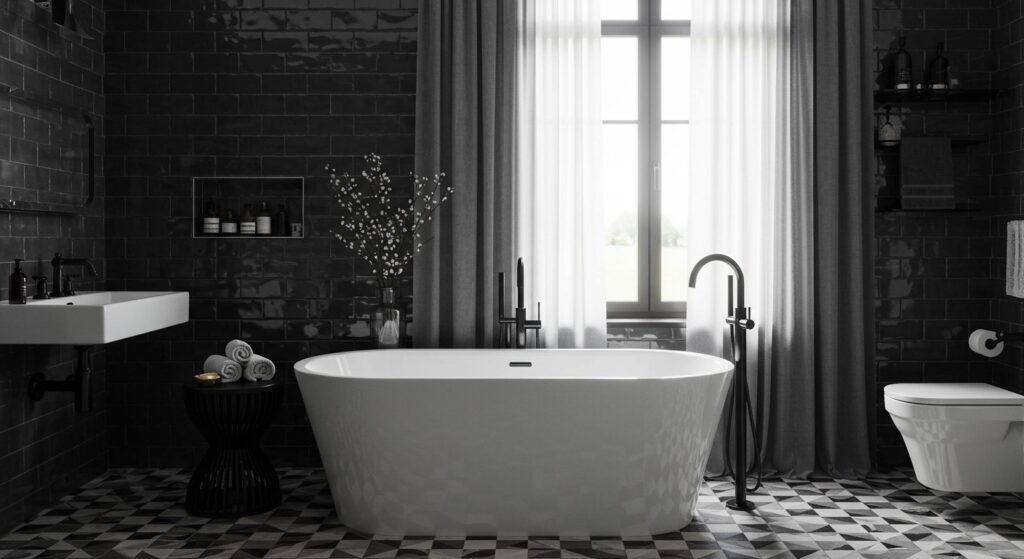There’s something undeniably captivating about a black and white bathroom. Maybe it’s the way these two contrasting shades create instant drama without feeling overwhelming. Or perhaps it’s how this palette works equally well in a compact powder room or a sprawling master suite.
Whatever draws you to this classic color combination, you’re tapping into a design approach that’s been popular for decades – and for good reason. A monochrome bathroom isn’t just visually striking; it’s surprisingly versatile. You can lean into vintage charm with checkerboard floors and pedestal sinks, or embrace sleek modernity with glossy tiles and minimalist fixtures.
The beauty of designing with black and white is that you’re working with a blank canvas that never really feels blank. These colors let patterns shine, make architectural details pop, and give you endless freedom to switch up your accessories and décor without starting from scratch. Ready to see how this timeless palette can transform your bathroom into something special?
Why Black and White Bathrooms Never Go Out of Style
Trends come and go, but some design choices have serious staying power. The black and white bathroom falls firmly into that category, and there are solid reasons why homeowners keep coming back to this combination.
For starters, this palette is incredibly forgiving when it comes to different design styles. Whether you’re drawn to farmhouse style living room aesthetics that extend throughout your home or prefer sleek contemporary lines, black and white adapts beautifully. It’s like having a wardrobe of classic pieces that you can dress up or down depending on your mood.
There’s also something refreshing about the clarity this color scheme brings. In a world where we’re constantly bombarded with visual noise, walking into a crisp black and white space feels like a breath of fresh air. It’s clean without being cold, sophisticated without trying too hard.
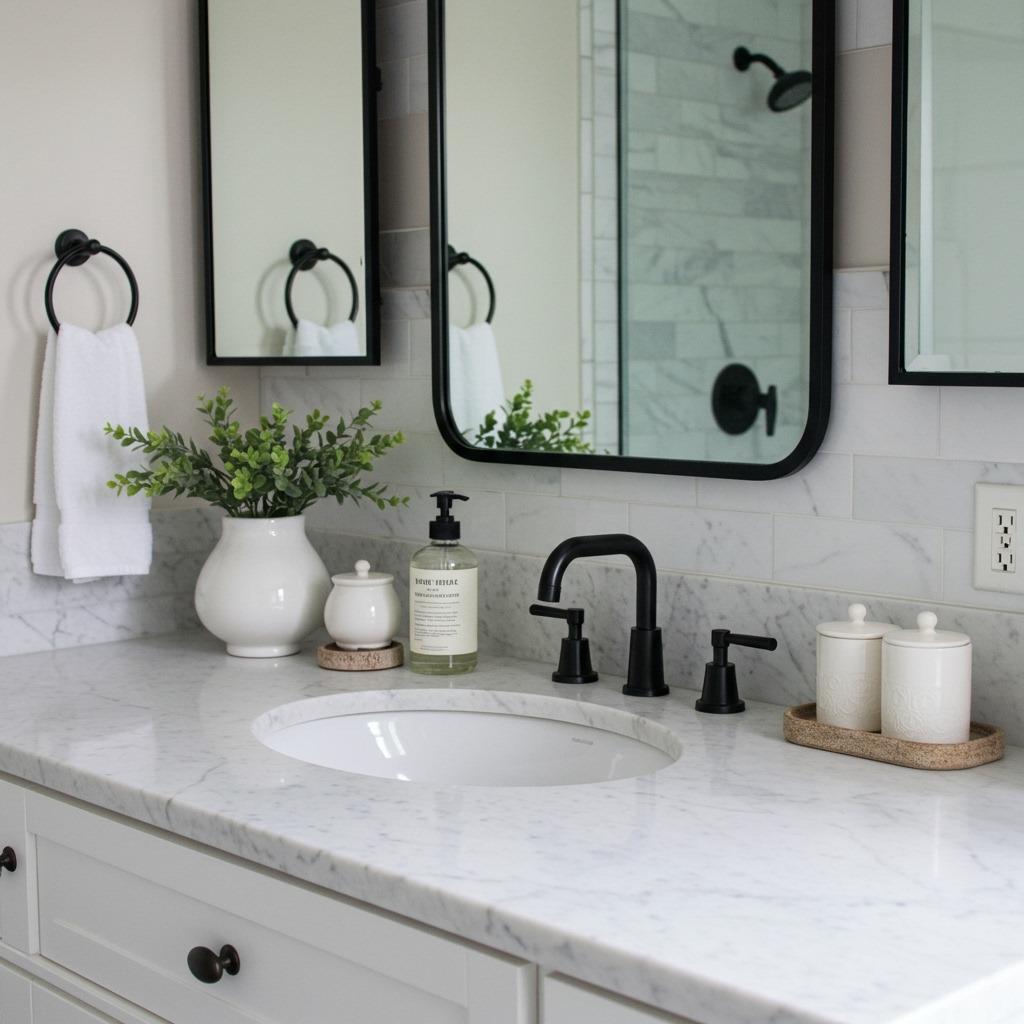
The practical side matters too. These colors don’t show wear the same way bold, trendy shades might. That turquoise you loved five years ago? It might feel dated now. But black and white? Still fresh, still relevant, still completely intentional-looking.
Creating Contrast Without Overwhelming the Space
Here’s where things get interesting – how much black is too much? This is probably the most common question when planning a monochrome bathroom, and honestly, there’s no one-size-fits-all answer.
Think about your bathroom’s natural light situation first. Does sunlight stream through a window most of the day, or are you working with a small, interior room? A bright space can handle more black without feeling cave-like, while a darker room might benefit from using black as an accent rather than the dominant color.
The 60-30-10 rule can be your friend here, though don’t feel locked into it. Many stunning bathroom ideas use roughly 60% white, 30% black, and 10% textures or metals. But I’ve seen gorgeous spaces that flip this completely – dramatic black walls with white fixtures and brass accents that absolutely work.
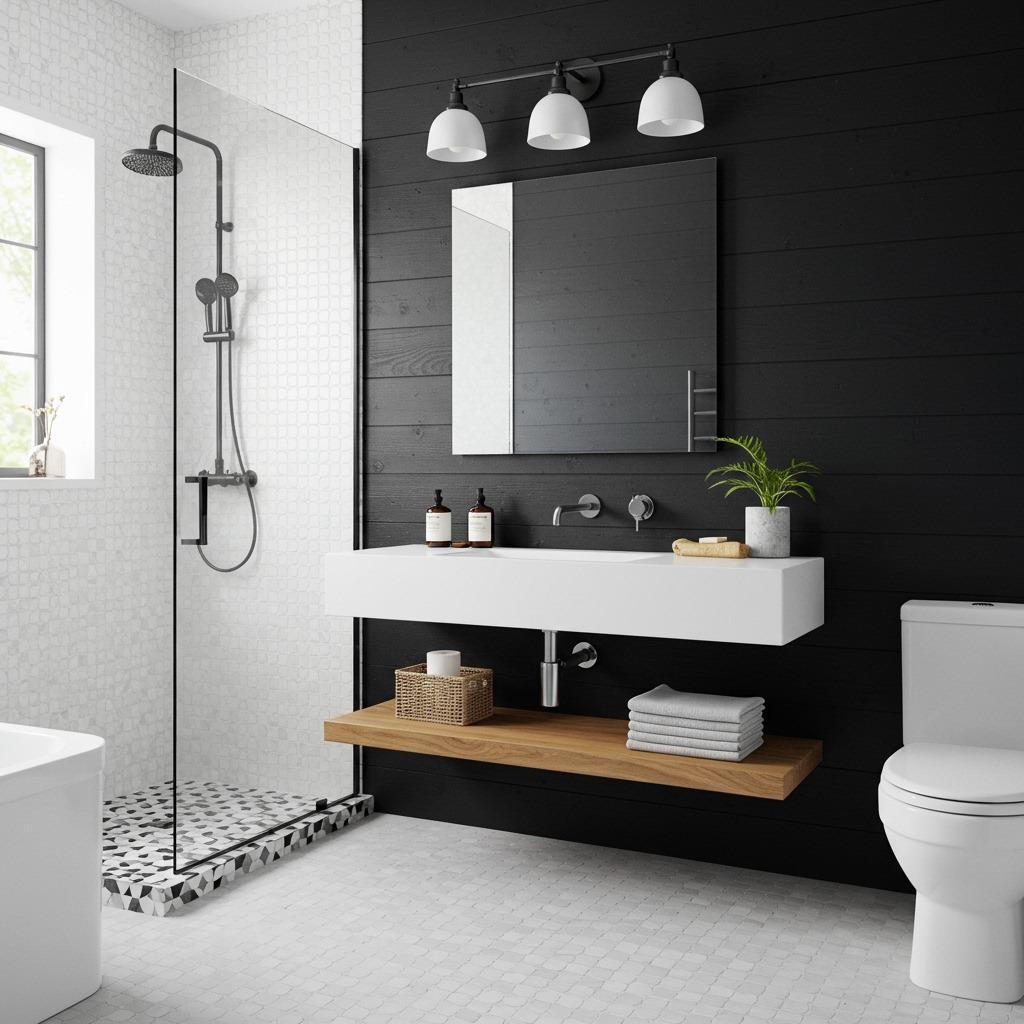
Consider where the eye naturally travels when you enter the room. Placing black in strategic spots – like on the floor or a single feature wall – creates visual weight that grounds the space. Spreading it evenly everywhere can sometimes flatten the look rather than add dimension.
Floor Patterns That Make a Statement
If there’s one place to have fun in your elegant bath, it’s the floor. This is where you can introduce personality and pattern without committing to something permanent on every surface.
Classic checkerboard tiles remain popular for good reason – they’re graphic, timeless, and surprisingly versatile. But you’re definitely not limited to that single option. Hexagonal tiles in alternating colors create a vintage vibe that feels fresh again. Or consider larger format tiles in black with white grout (or vice versa) for a more contemporary take.
Geometric patterns are having a moment, and they work beautifully in neutral color bath designs. Moroccan-inspired encaustic tiles bring intricate detail underfoot, while herringbone or chevron patterns add movement without busy-ness. The key is choosing a pattern scale that fits your room size – tiny, intricate patterns can get lost in large spaces, while bold, oversized designs might overwhelm a small powder room.
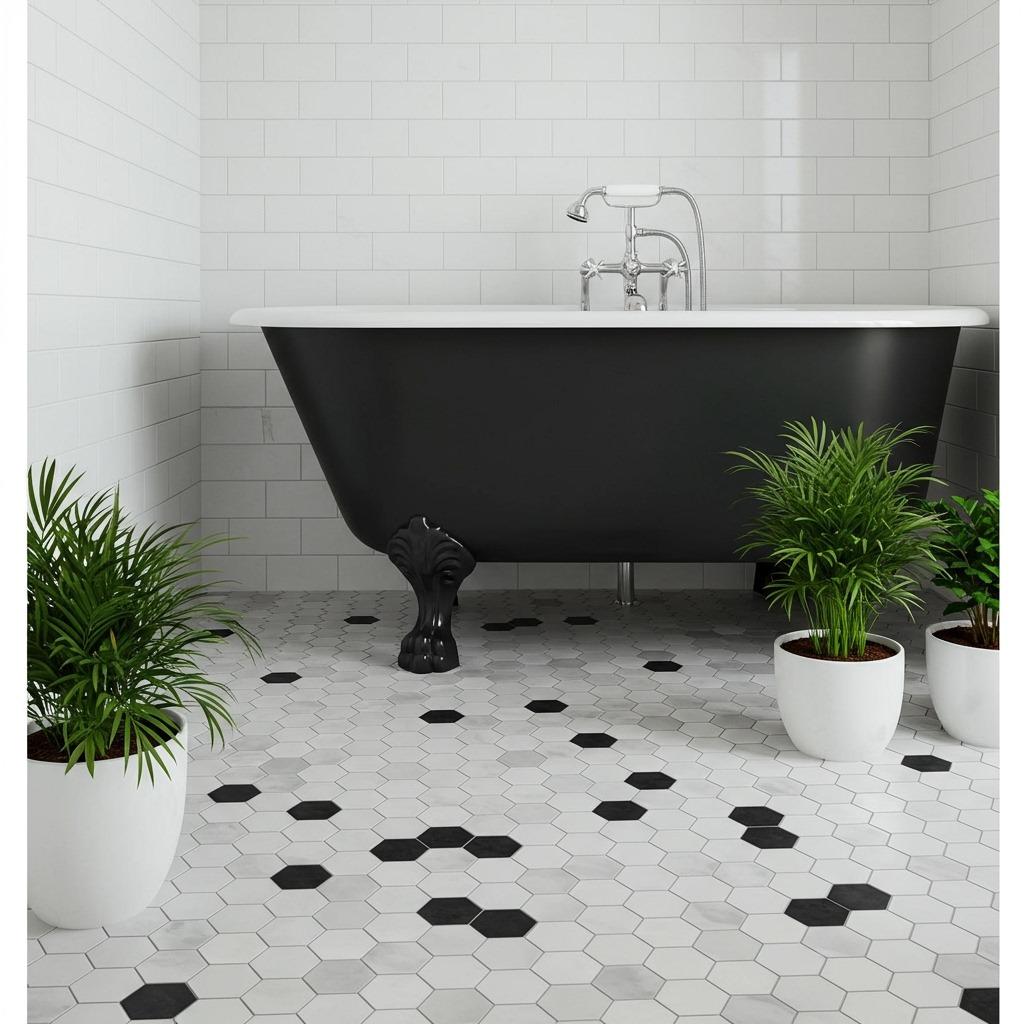
Don’t underestimate the power of a simple stripe either. Laying rectangular tiles in a striped pattern creates subtle visual interest that’s sophisticated rather than showy. And here’s a design trick – running your floor pattern diagonally can make a small bathroom feel more spacious.
Wall Treatments Beyond Standard Tiles
Sure, classic subway tiles work wonderfully (we’ll get to those), but walls offer so much opportunity for texture and interest. This is your chance to add layers to what could otherwise be a flat color story.
Shiplap painted in crisp white with modern accent wall ideas incorporating black creates farmhouse charm that still feels polished. Or go the opposite direction with glossy black walls that reflect light and create an unexpectedly glamorous vibe. Matte black paint offers drama without the shine, working especially well if you have interesting architectural details you want to highlight.
Beadboard wainscoting painted white with black walls above introduces traditional detailing without feeling stuffy. This two-tone approach also offers practical benefits – the wainscoting takes the brunt of moisture and wear in the lower portion of your walls.
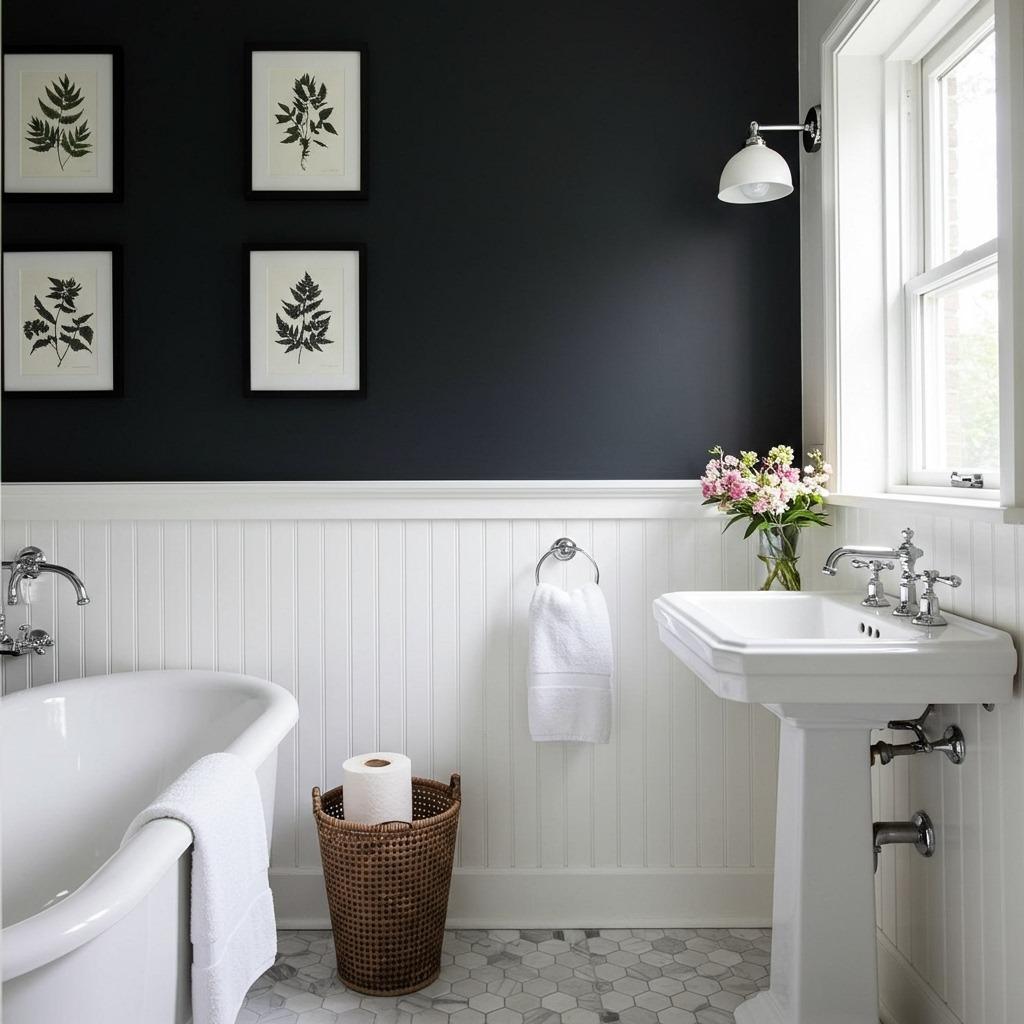
If you’re drawn to pattern on your walls, consider scale carefully. Large-scale patterns read as sophisticated, while tiny patterns can sometimes feel busy. Black and white wallpaper in a bold damask or subtle grass cloth texture adds tactile interest that paint alone can’t achieve. Just be sure to use wallpaper rated for bathrooms if you’re installing it in a high-moisture area.
Tile doesn’t have to mean predictable, either. Stacked subway tiles create a contemporary look, while vertical stacking makes ceilings feel higher. Mix tile sizes and shapes – like pairing subway tiles with smaller square accent tiles – for custom appeal without custom costs.
Fixture Finishes That Elevate the Design
The hardware and fixtures you choose might seem like small details, but they completely transform how your black and white bathroom feels. This is where you inject warmth, personality, and that final layer of intention.
Matte black fixtures have become incredibly popular, and for good reason. They offer modern sophistication while being surprisingly practical – water spots and fingerprints don’t show as readily as on chrome. A minimalist bathroom design approach often incorporates these sleek black faucets, showerheads, and towel bars for clean, uninterrupted lines.
But don’t feel limited to black or chrome. Brass and gold fixtures create stunning warmth against the cool contrast of black and white. This combination feels both vintage and completely current, especially when you use unlacquered brass that develops a patina over time. Brushed nickel offers a softer middle ground if you want warmth without quite as much statement.
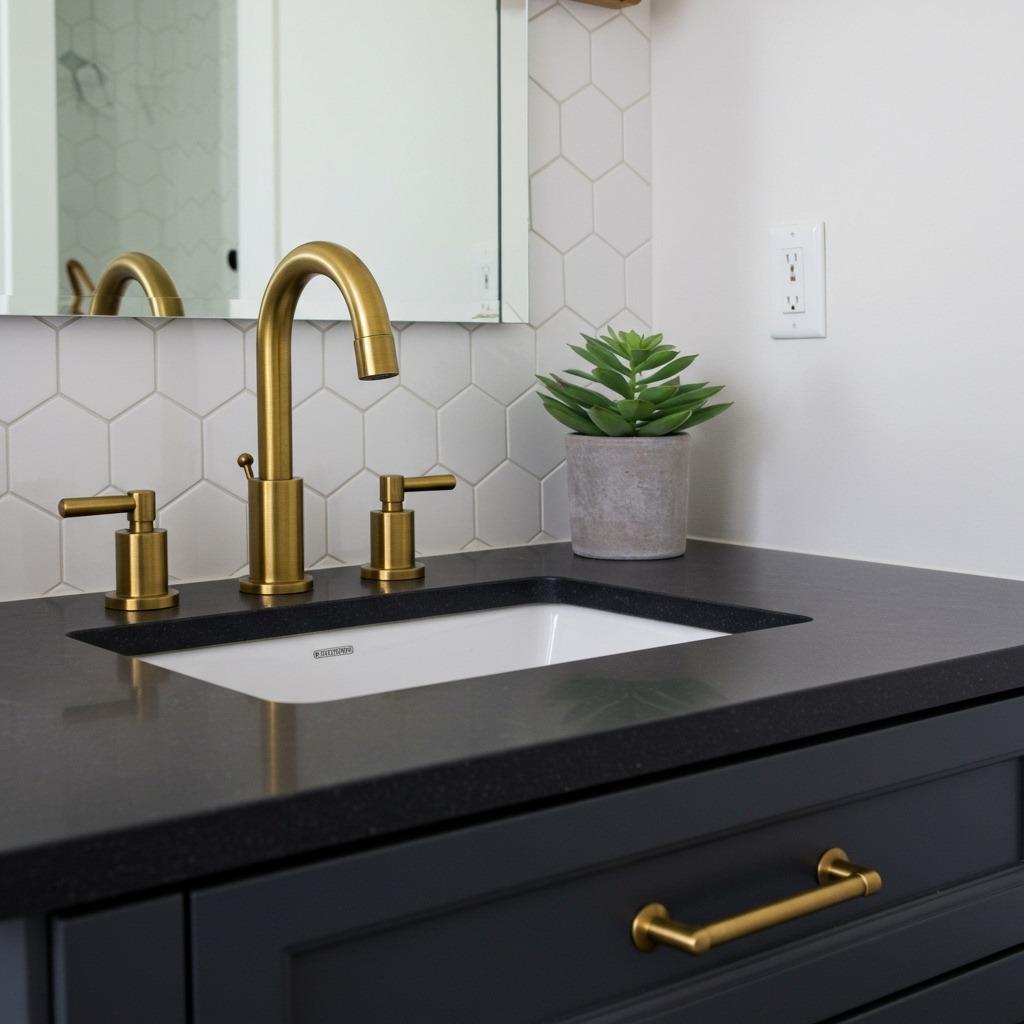
Consider mixing metals intentionally rather than accidentally. A cohesive look doesn’t mean everything matches exactly – your light fixtures might be matte black while your faucets are brass, unified by your thoughtful color palette. The key is having a clear plan rather than just using whatever was on sale.
Lighting Solutions for Depth and Ambiance
Good lighting might be the most underrated element in bathroom design. In a monochrome bathroom, it becomes even more critical because you’re relying on light and shadow to create visual interest rather than color variation.Layer your lighting just like you would in any
well-designed room. Overhead lighting provides general illumination, but that’s just your starting point. Wall sconces flanking your mirror create flattering, shadow-free lighting for daily routines. This is where many homeowners appreciate insights from affordable home upgrades about which changes make the biggest impact.
Black light fixtures make bold statements – a matte black chandelier or pendant light becomes sculptural art when paired with white walls. Consider globe lights with black cords and fixtures for a vintage-industrial vibe, or sleek linear fixtures for contemporary spaces.
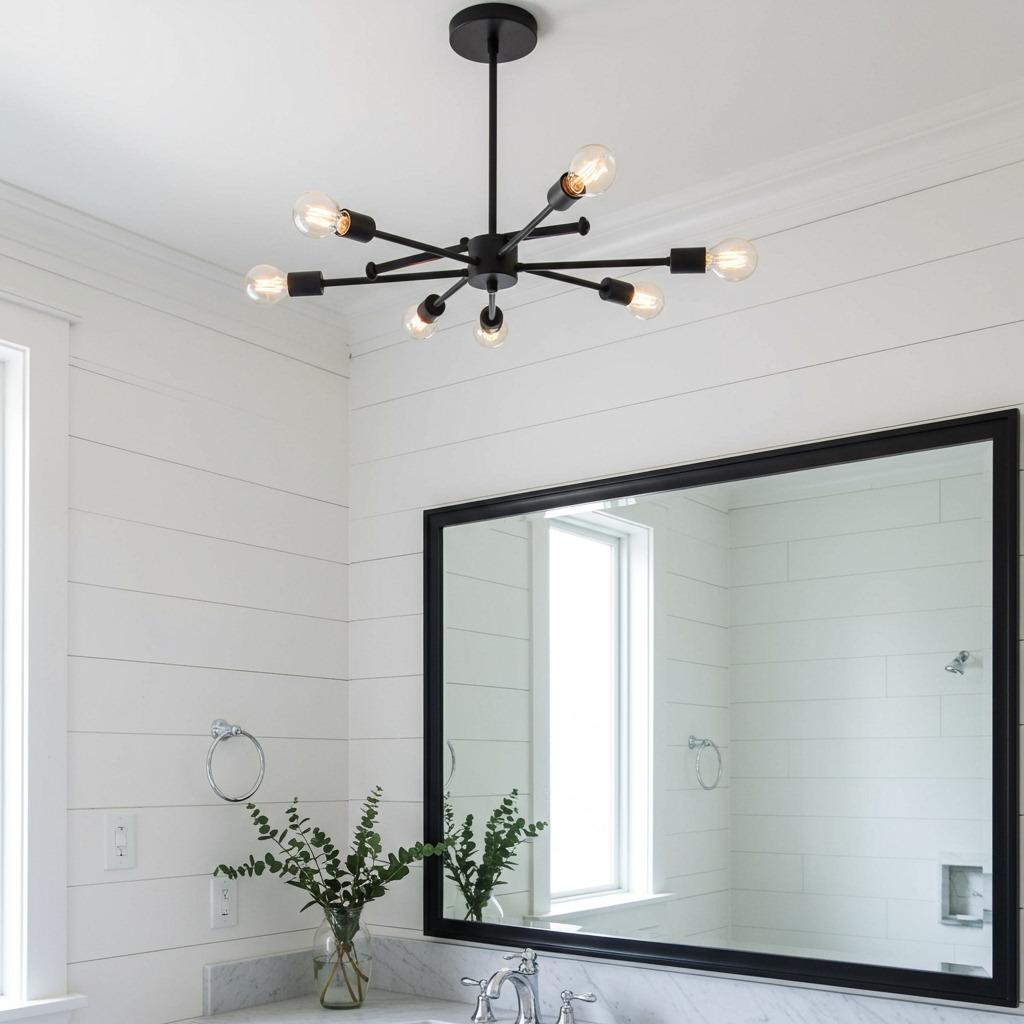
Don’t overlook accent lighting possibilities. LED strips under floating vanities create a modern glow that makes the vanity appear to hover. Small picture lights above framed artwork add
gallery-style sophistication. Even something as simple as a dimmer switch transforms your bathroom from bright and energizing in the morning to soft and spa-like in the evening.
Natural light deserves attention too. If you’re blessed with a window, treat it thoughtfully. Frosted glass maintains privacy while allowing light. Black window frames create architectural interest and draw the eye to views. Simple white roman shades or black shutters control light without competing with your overall design.
Incorporating Texture for Visual Interest
Without color to add dimension, texture becomes your secret weapon. This is what separates a flat, uninspired monochrome bathroom from one that feels rich and thoughtfully designed.
Think about the surfaces in your bathroom – smooth glossy tiles reflect light and feel sleek, while matte finishes absorb light and feel softer. Mixing these finishes creates subtle contrast that your eye registers even if you don’t consciously notice it. A glossy white subway tile paired with matte black floor tiles, for instance, offers textural variety that keeps things interesting.
Wood elements introduce warmth that prevents your black and white space from feeling too stark. A wooden vanity painted white, open shelving in natural wood, or even a simple wooden stool creates organic texture. If you’re inspired by spa inspired bathroom aesthetics, incorporating natural materials feels especially appropriate.
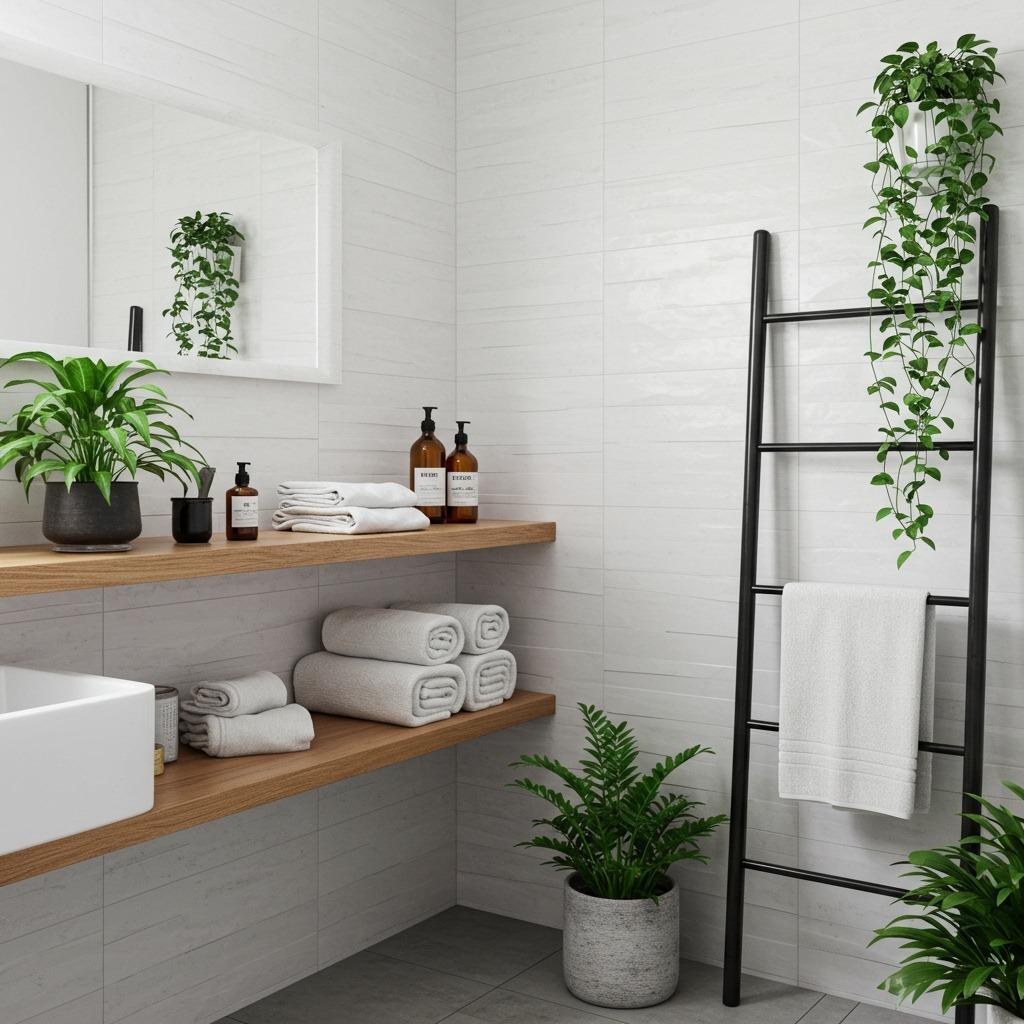
Textiles matter more than you might expect. Plush white bath mats, waffle-weave towels, a woven basket for storage – these elements soften hard surfaces and add tactile interest. Even something as simple as switching from smooth towels to chunky, textured ones shifts the entire feel of your space.
Don’t forget about the smaller details. Ribbed glass soap dispensers, ceramic canisters with subtle patterns, natural sea sponges – these accessories introduce texture at eye level where you interact with them daily. The goal isn’t to clutter your counters but to select a few textured pieces that feel both beautiful and useful.
Storage Solutions That Maintain the Aesthetic
Storage can make or break any bathroom, but in a black and white bathroom, your organizational solutions need to work double duty – keeping things tidy while contributing to the overall look.
Open shelving in black metal offers both storage and display opportunity. This is where you can style white towels rolled like at a boutique hotel, place beautiful bottles and jars, and maybe add a plant or two. The key is maintaining the same intentional color story on your shelves as you do in the rest of the room.
Built-in niches in your shower tiled to match your walls provide storage that feels seamless rather than added on. Paint the inside of a niche black while keeping surrounding walls white, and suddenly you have architectural interest along with your practical storage. For more small-space strategies, check out small bathroom renovation ideas that maximize every inch.
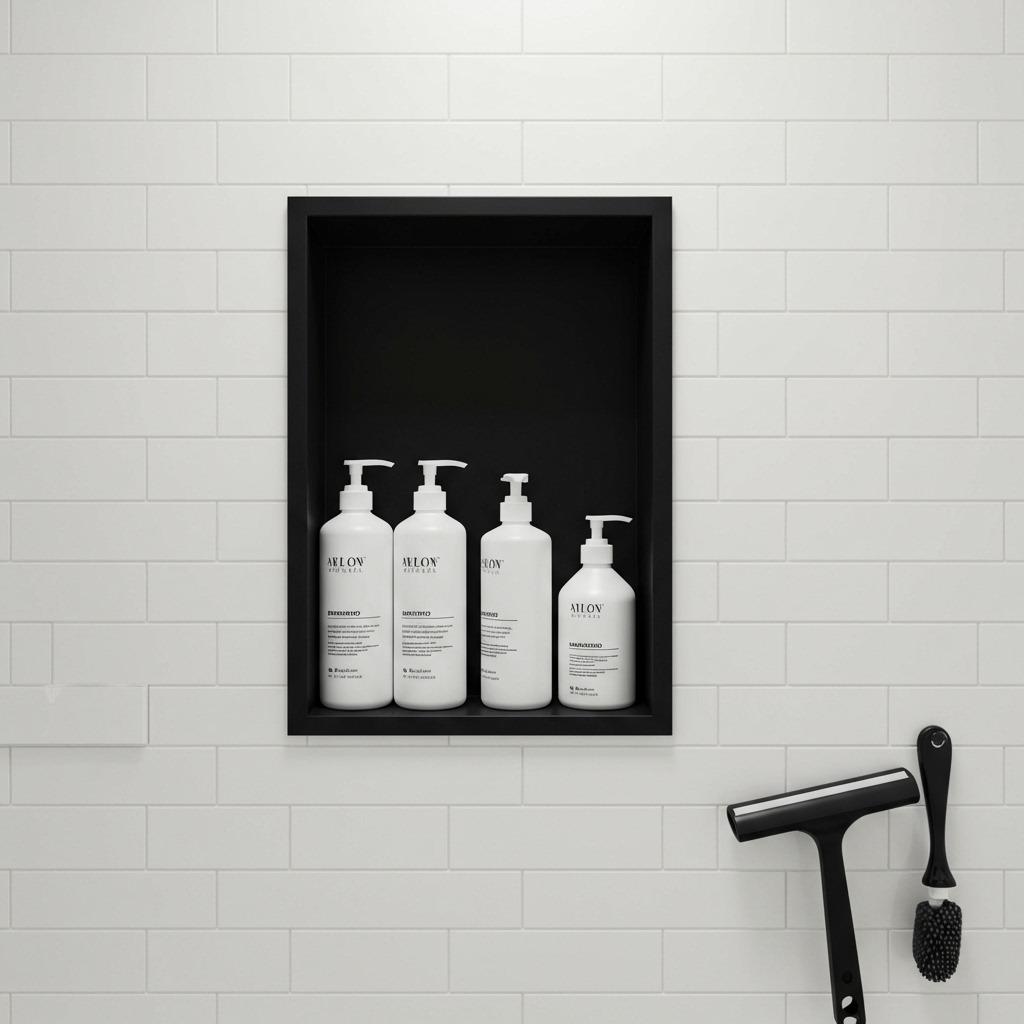
Vanity storage becomes simpler when your color scheme is limited. Black baskets on white shelves, white bins in a dark vanity – organizational containers become part of your design rather than something to hide. Under-sink areas can be transformed with matching containers that look intentional when doors open.
Medicine cabinets don’t have to be boring, either. Black-framed medicine cabinets become mirrors with hidden storage, combining function and style. Or consider a black cabinet with glass front – it becomes a display opportunity for pretty bottles and jars while keeping them dust-free and organized.
Small Space Strategies for Maximum Impact
Working with a compact bathroom? This color combination might be your best friend. There’s a reason so many small space renovation projects embrace black and white – it visually expands a room when done thoughtfully.
Keep your black elements lower – on floors or lower cabinets – while maintaining white on walls and ceilings. This grounds the space without making it feel closed in. It’s similar to how wearing dark pants and a light top creates a balanced silhouette; the same principle applies to rooms.
Large-format tiles with minimal grout lines make a small bathroom feel more spacious than lots of tiny tiles. Whether you choose white tiles with black grout or black tiles with white grout, fewer grout lines mean less visual interruption and a cleaner, more open feel.
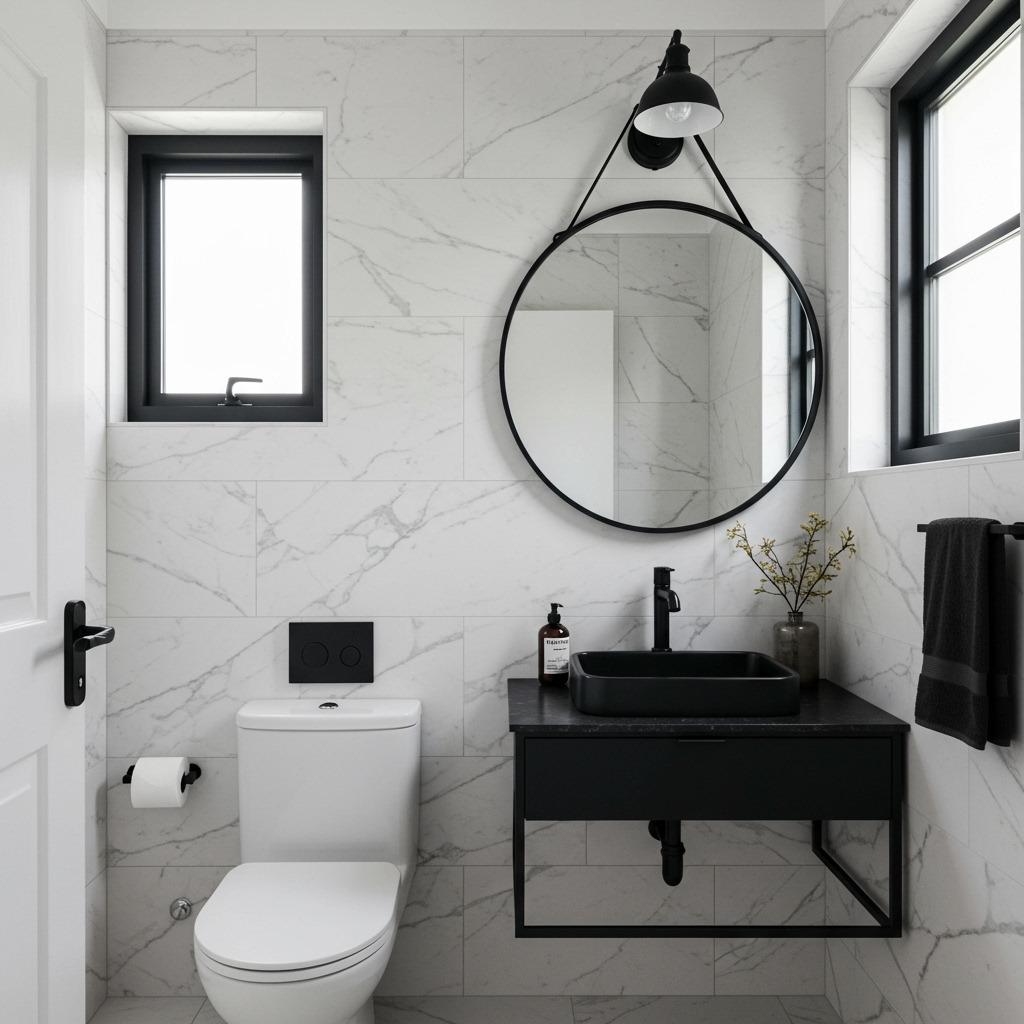
Mirrors become even more valuable in small spaces. A large mirror extending from counter to ceiling bounces light and creates the illusion of depth. Black frames on oversized mirrors create impact without overwhelming a small room – the frame reads as architectural detail rather than just functional necessity.
Consider a floating vanity in white with black countertop. The visible floor space underneath makes the room feel larger, while the color contrast draws the eye up and around the room rather than stopping at heavy, floor-mounted cabinetry.
Adding Life With Plants and Natural Elements
A black and white bathroom can feel sophisticated but sometimes risks feeling a bit sterile. This is where plants and natural elements save the day, introducing organic shapes and that essential connection to nature.
Greenery pops beautifully against monochrome backgrounds. A fiddle leaf fig in a white pot becomes a sculptural element in the corner. Small succulents lined up on a window sill add life without maintenance hassle. Even a simple eucalyptus bundle hanging in your shower brings spa-like freshness. These natural touches complement plant filled bathroom concepts that are gaining popularity.
Choose planters that complement your color scheme – white ceramic, matte black pots, or natural materials like woven baskets or wood. The planters themselves become part of your design story rather than random additions.
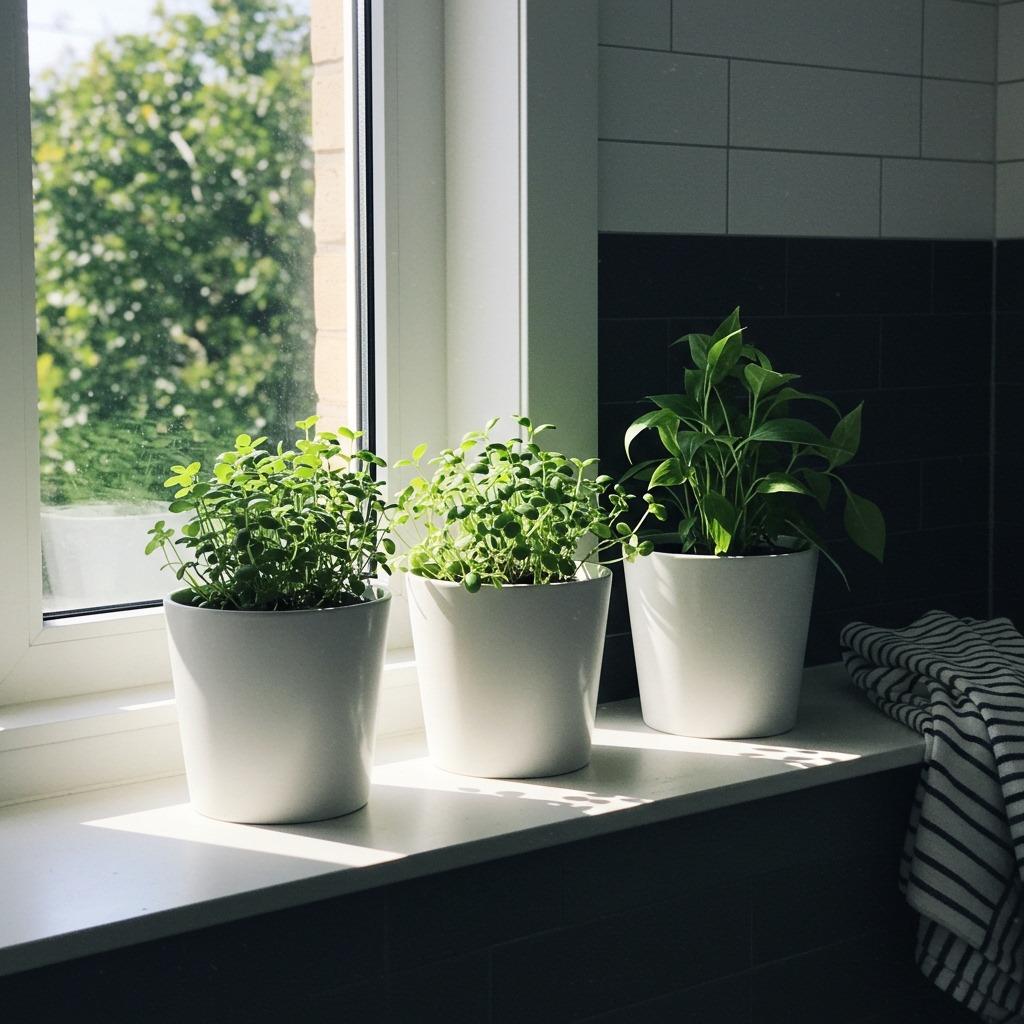
Natural wood elements add warmth that prevents your space from feeling too cold or clinical. A wooden bath tray across your tub holding a candle and book creates a relaxing moment. Wooden frames on black and white photography or botanical prints introduce organic texture at eye level.
Stone elements work beautifully too. White marble countertops with dramatic black veining pick up both colors in your palette. River rocks in a black bowl become sculptural décor. Even something as simple as a piece of driftwood propped against white tile introduces natural curves into a space dominated by straight lines and hard surfaces.
Vintage Charm Meets Modern Sensibility
One of the most appealing aspects of designing with black and white is how it bridges different eras. You can create a space that nods to the past while feeling completely current.
Classic checkerboard floors paired with contemporary fixtures give you best-of-both-worlds appeal. A vintage clawfoot tub painted glossy black becomes a showstopper against white walls, especially when you add modern brass plumbing fixtures. This mix of old and new creates character that feels collected rather than cookie-cutter.
Subway tiles are classic for good reason, but how you style them makes all the difference. Traditional running bond (brick) pattern feels timeless, while vertical stacking looks contemporary. Dark grout on white tiles creates that vintage apothecary vibe, while matching white grout keeps things crisp and modern. These choices work beautifully in modern bathroom tile designs.
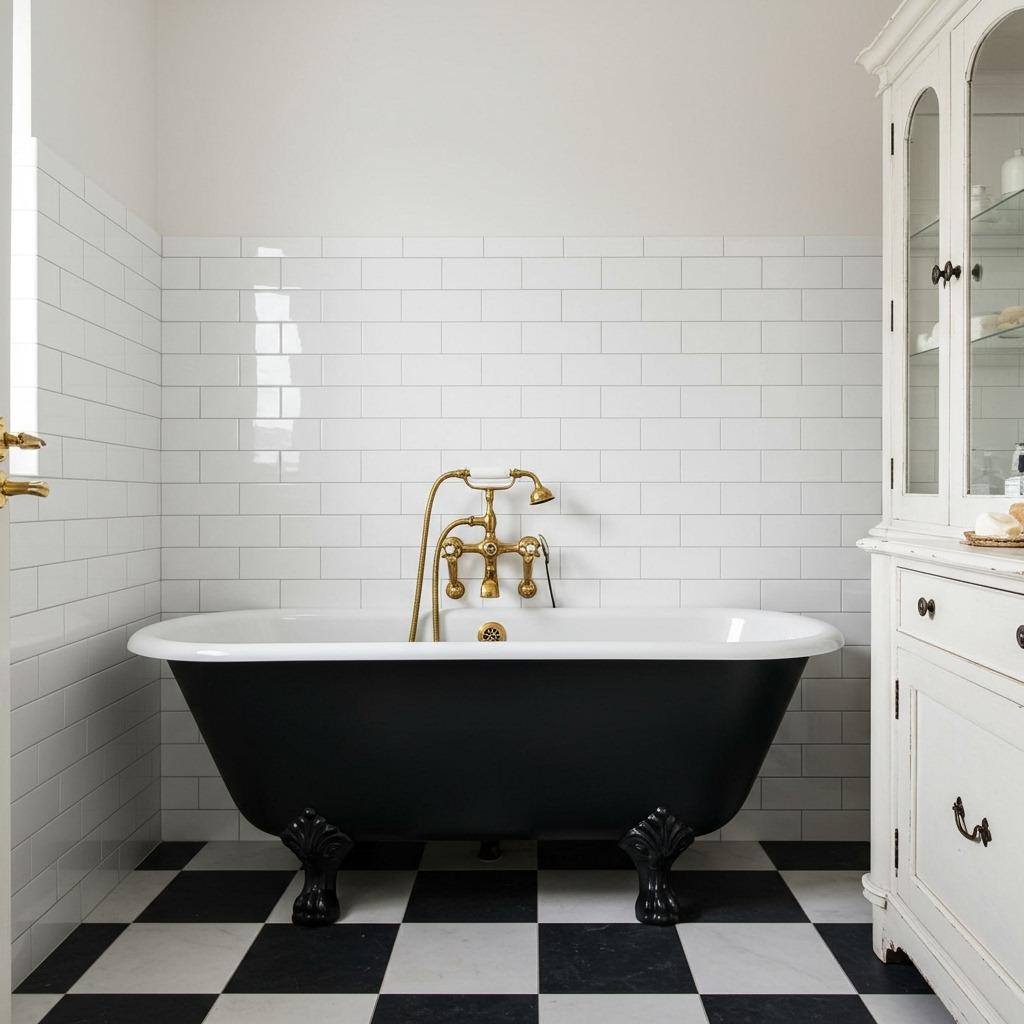
Mix furniture pieces rather than buying matching bathroom furniture sets. An antique dresser converted to a vanity painted white with black countertop combines character and function. Modern floating shelves in matte black provide storage that doesn’t compete with vintage elements.
Lighting offers another opportunity to blend eras. An industrial-style black pendant light contrasts beautifully with traditional details like beadboard wainscoting. Or pair sleek, modern sconces with vintage-inspired black and white floor tiles for an unexpected combination that somehow just works.
Maintenance and Practical Considerations
Let’s be honest about the practical side of living with a black and white bathroom. Understanding what to expect helps you make informed decisions about materials and finishes.
Black surfaces show water spots and dust more readily than other colors. Matte black finishes hide these imperfections better than glossy black, which can show every fingerprint. If you love the look of glossy black but worry about maintenance, consider using it in spots you don’t touch frequently – like a glossy black tub exterior rather than glossy black countertops.
White grout requires more maintenance than dark grout, there’s no way around it. Sealing it properly helps, but you’ll still need to clean it regularly. If you love the look of white tile with white grout but want to minimize maintenance, consider larger tiles with fewer grout lines, or use an epoxy grout that resists staining better than traditional cement-based grout.
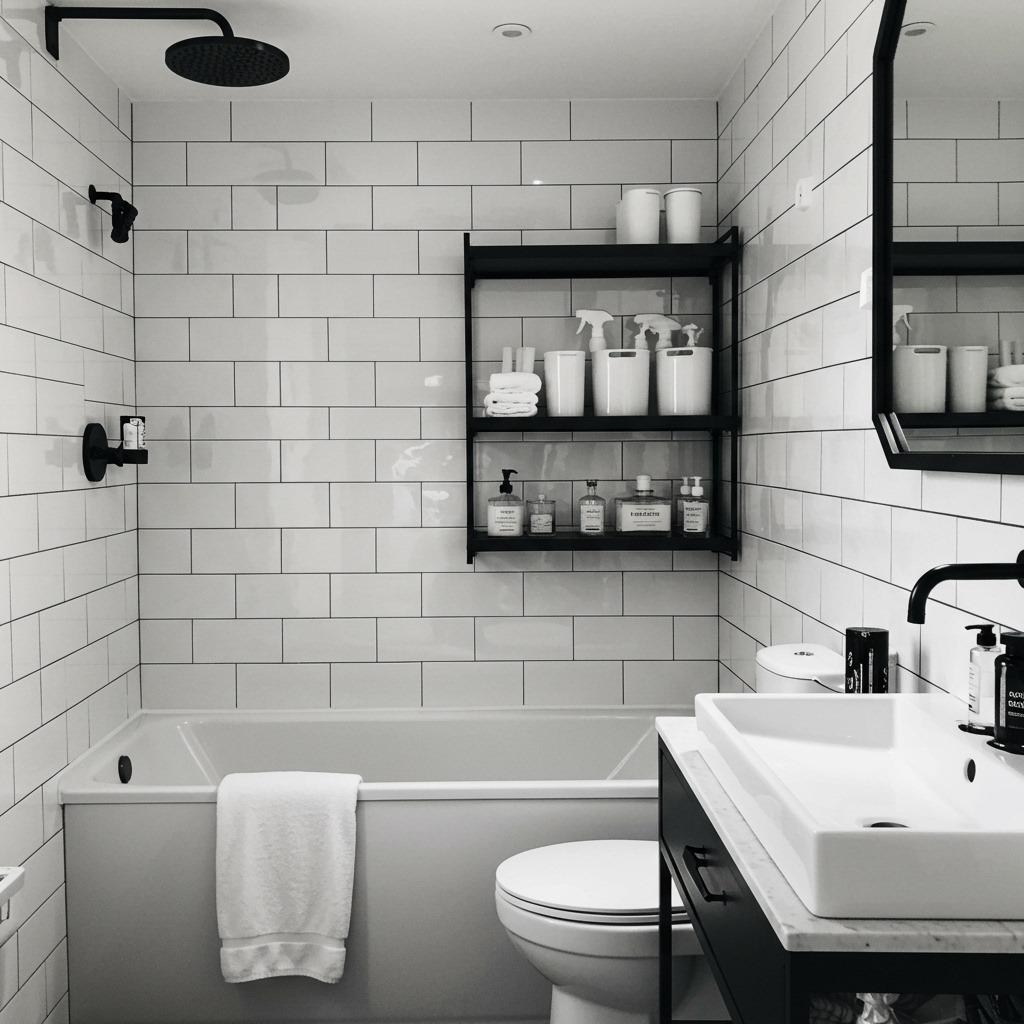
Good ventilation becomes especially important in any bathroom, but particularly when using dark colors that can show moisture and mildew more readily. A properly sized exhaust fan removes humidity that can lead to problems. Opening windows when weather permits helps too.
Choose quality materials that can handle daily use. In high-traffic areas, porcelain tiles outperform ceramic in durability. For countertops, quartz resists staining better than marble, though marble’s natural veining creates beautiful movement.
Budget-Friendly Approaches to the Look
Creating a stunning black and white bathroom doesn’t require unlimited funds. Smart choices let you achieve high-end looks without the price tag.
Paint is your most powerful budget tool. Painting existing cabinets black or white transforms them entirely for the cost of a few cans of paint and some sweat equity. Even painting your existing bathtub (yes, this is possible with the right products) creates a fresh look. Wall paint in dramatic black or crisp white changes your entire space for minimal investment.
Peel-and-stick tiles have come a long way. While they won’t hold up in a shower, they work beautifully for accent walls or backsplashes. Black and white peel-and-stick geometric patterns let you achieve the look of expensive encaustic tiles for a fraction of the cost. This approach aligns with affordable home upgrades that deliver visual impact without breaking the bank.
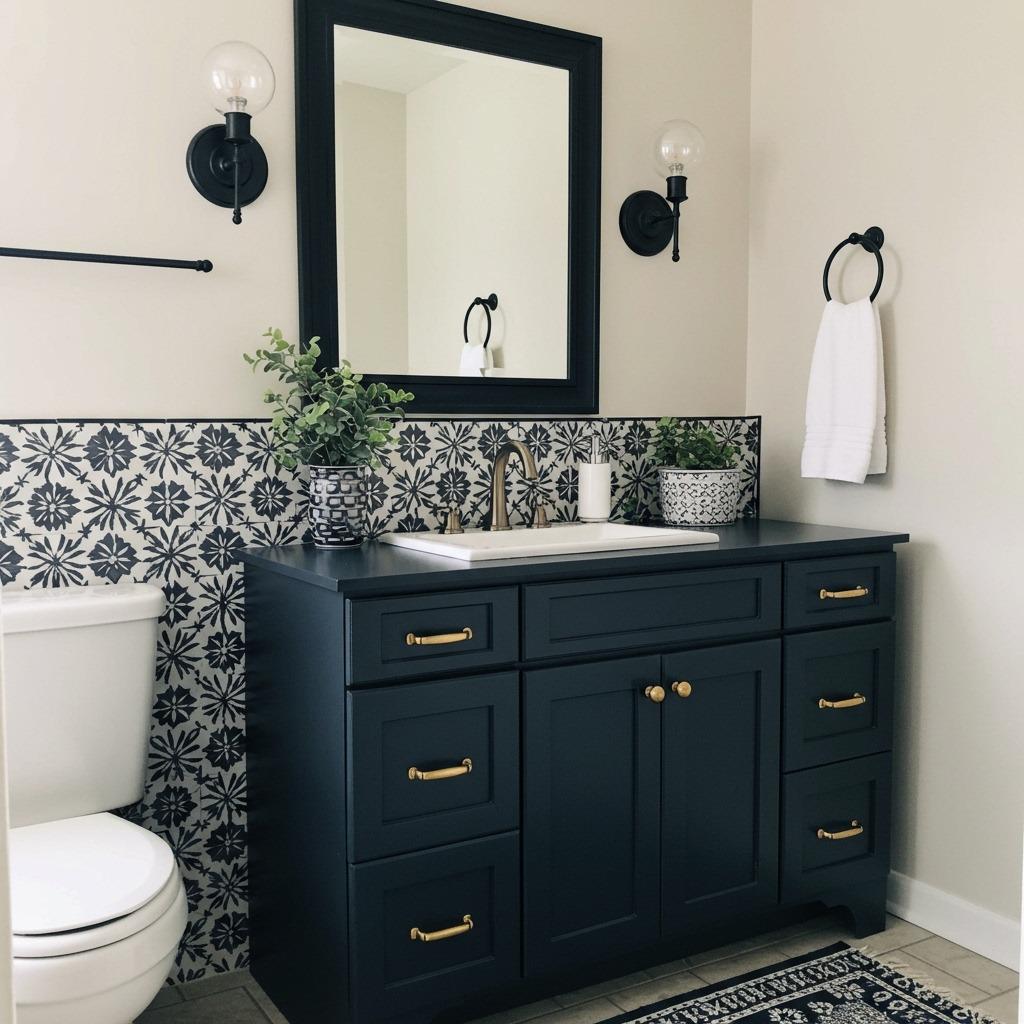
Shop secondhand for unique pieces. Vintage mirrors, old dressers you can convert to vanities, antique light fixtures – these items bring character that new mass-produced pieces can’t match. A vintage black mirror frame costs a fraction of a new designer mirror but delivers authentic character.
Focus your budget on what matters most. If you can only afford to replace one thing, replacing dated brass fixtures with black ones creates instant modernization. If flooring is in decent shape, work with it by building your design around existing tile rather than replacing it.
DIY what you can comfortably tackle. Installing a new faucet, painting walls, adding open shelving, upgrading light fixtures – these projects save significant money on labor while letting you invest more in quality materials where it matters.
The enduring appeal of a black and white bathroom lies in its ability to be whatever you need it to be. Classic yet contemporary. Dramatic yet serene. Budget-friendly yet luxurious-looking. It’s a palette that grows with you, adapting as your style evolves while maintaining its fundamental sophistication.
Whether you’re planning a complete overhaul or simply refreshing your current space, the principles remain the same. Balance your dark and light elements thoughtfully. Layer in texture to prevent flatness. Add warmth through wood, brass, or greenery. And most importantly, let your personal style guide your choices rather than following trends blindly.
Your black and white bathroom can be bold and graphic or soft and subtle. It can reference vintage charm or embrace sleek modernism. The beauty of this timeless combination is that the foundation never goes out of style, even as you change accessories, update fixtures, or add new elements over time. That’s the kind of design confidence worth investing in.

